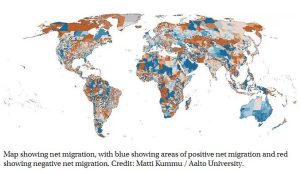Economics a bigger driver of migration than climate – study
Global net-migration patterns are more strongly linked with socio-economic factors rather than climate change, according to new research.
The researchers, from Aalto University, Finland, and the University of Bologna, Italy, took birth and death data from 216 countries or sovereign states covering the two decades from 2000 to 2019.
 They fine-tuned their statistics by taking sub-national data for births by dividing countries into more than 4,500 administrative units like states or provinces.
They fine-tuned their statistics by taking sub-national data for births by dividing countries into more than 4,500 administrative units like states or provinces.
“Our findings don’t really match the narrative that’s repeated by the public about climate-induced migration,” said lead author Dr Venla Niva from Aalto University, Finland.
“When you look at the different factors together, the analysis shows that human development factors are more important drivers than climate.”
The high-resolution data, published in the journal Nature Human Behaviour, allowed the researchers to answer questions that can’t be answered by data based on national averages.
“There was a real need for a dataset like this, but it didn’t exist. So, we decided to make it ourselves,” Dr Niva said.
“Climate factors don’t follow administrative boundaries, so data like this is needed if you want to study these patterns.”
Combining birth and death rates with overall population growth, the team was able to estimate net migration.
Socio-economic and environmental factors were assessed through the UN’s Human Development Index (HDI) and the aridity index.
Dr Niva said it was not the poorest of the poor who are fleeing environmental disasters or environmental changes. Migration is an adaptation method used by people who have the capacity to move.
Areas such as the Arabian Peninsula, North America, Australia and the north Mediterranean were net receivers of migrating people, despite their high aridity.
“Decision-makers should pay attention to this. Rather than focusing solely on border closures and combating migration, we should work to support and empower individuals in economically disadvantaged countries. That would help reduce the drivers that compel people to migrate in search of better opportunities,” the researchers said.
The study also reveals differences between migration patterns within countries.
“In France and Italy, for example, there are really interesting differences between north and south, and in Spain there’s an east-west difference. There are so many patterns that national experts could look into, and of course the reasons behind them might be different for each country,” the researchers said.
“There’s a very common belief that urban areas are pulling the people from the rural areas, but that wasn’t the case everywhere. For example, there are a lot of places for example in Europe where the opposite is true.
Migration from cities to rural areas was also observed in parts of Indonesia, Congo, Venezuela, and Pakistan.
“Overall, migration is more complex than people tend to think. Our findings contribute to the discussion of where and how migration is happening – it’s not actually a Eurocentric phenomenon, because most migration happens elsewhere in the world.”
“When you look at the different factors together, the analysis shows that human development factors are more important drivers than climate,” Dr Niva said.
See the data set and interactive map: World’s human migration patterns in 2000–2019 unveiled by high-resolution data | Nature Human Behaviour












